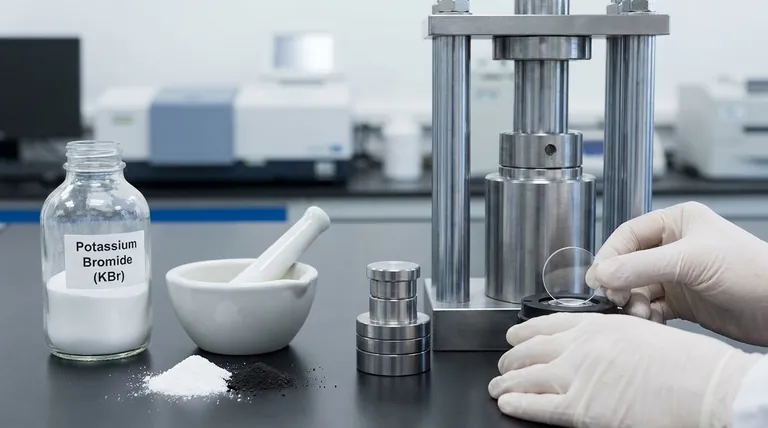In the field of analytical chemistry, Potassium Bromide (KBr) serves a very specific and critical function. It is predominantly used as an ideal matrix material for preparing solid samples for analysis via Fourier-transform infrared (FTIR) spectroscopy. The sample is finely ground and mixed with KBr powder, then pressed under high pressure to form a thin, transparent pellet that allows infrared light to pass through it.
The core reason for using KBr is its unique optical property: it is transparent to infrared radiation across a wide spectral range. This allows the spectrometer to measure the light absorbed by the sample itself without interference from the surrounding material.

The Role of KBr in Infrared Spectroscopy
To analyze a solid material using transmission IR spectroscopy, the infrared beam must be able to pass through it cleanly. Simply placing a chunk of an opaque solid in the spectrometer would block the beam entirely. KBr provides the solution by acting as a solid-state "solvent" or window.
Why Transparency is Critical
The goal of IR spectroscopy is to identify the functional groups within a molecule by measuring which frequencies of infrared light are absorbed. For this to work, the material holding the sample must not absorb light in the same region.
KBr does not have any molecular vibrations that absorb light in the typical mid-infrared range (4000 to 400 cm⁻¹). This makes it an almost perfectly clear window, ensuring that any absorption peaks detected in the spectrum come from your sample, not the KBr matrix.
The KBr Pellet Method Explained
The process involves meticulously mixing a small amount of the solid sample (typically 1-2% by weight) with pure, dry KBr powder. The mixture is ground to an extremely fine, uniform consistency to prevent light scattering.
This powder mixture is then placed into a die and pressed under immense pressure (several tons). The pressure causes the soft KBr crystals to flow and fuse, forming a solid, translucent, or transparent disk, trapping the sample particles within it.
Key Properties Making KBr Ideal
KBr is not the only material that can be used, but it is the most common due to its combination of properties:
- Optical Transparency: As mentioned, it is non-absorbing in the most useful region of the IR spectrum.
- Softness and Plasticity: KBr is a relatively soft crystalline salt. Under pressure, it deforms and fuses into a solid disk rather than shattering.
- Hygroscopic Nature: KBr readily absorbs moisture from the atmosphere. While this requires careful handling and drying, it also means KBr is soluble in water, making cleanup easy.
Understanding the Trade-offs and Pitfalls
While KBr is the industry standard, its properties demand careful technique. The warnings provided in lab procedures are directly tied to overcoming its inherent challenges.
The Challenge of Moisture
Because KBr is hygroscopic, it will absorb ambient water from the air. Water has very strong and broad absorption bands in the IR spectrum, which can easily obscure important peaks from your sample.
This is precisely why protocols demand drying the KBr powder in an oven (e.g., at 110 °C) before use and preparing the pellet quickly.
The Importance of Particle Size
If the sample or KBr particles are too large, they will scatter the infrared light instead of allowing it to pass through cleanly. This phenomenon, known as Mie scattering, results in a poor-quality spectrum with a sloping, uneven baseline and reduced signal intensity.
This is why procedures specify pulverizing the KBr to a fine mesh size and grinding it thoroughly with the sample.
Oxidation and Discoloration
Heating KBr too rapidly or at excessively high temperatures can cause it to oxidize, converting some Potassium Bromide (KBr) into Potassium Bromate (KBrO₃).
This chemical change not only introduces an impurity but can also cause a brownish discoloration in the pellet, indicating a compromised and unreliable matrix material.
Pellet Quality and Vacuum
Applying a vacuum during the pressing process is essential. It removes trapped air from the powder mixture.
Without a vacuum, air pockets create imperfections that scatter light and compromise the mechanical integrity of the pellet, making it opaque, brittle, and easy to break.
Best Practices for Preparing KBr Pellets
Achieving a high-quality spectrum is entirely dependent on the quality of your KBr pellet. Your specific focus should guide your technique.
- If your primary focus is spectral accuracy: Prioritize the thorough drying of both the KBr and your sample to completely eliminate the broad, interfering absorption peaks from water.
- If your primary focus is signal quality: Concentrate on meticulous grinding to create a fine, homogenous powder, which is the single most important step for minimizing light scattering and achieving a flat baseline.
- If your primary focus is pellet integrity: Ensure a strong and consistent vacuum is pulled during pressing to create a durable, mechanically stable, and transparent disk.
Mastering this simple preparation technique is fundamental to generating reliable and clear analytical data for solid materials.
Summary Table:
| Key Property of KBr | Role in FTIR Spectroscopy |
|---|---|
| Optical Transparency | Acts as a clear window, allowing IR light to pass through without absorption. |
| Plasticity | Fuses under pressure to form a solid, transparent pellet. |
| Hygroscopicity | Requires careful drying to avoid moisture interference in the spectrum. |
Generate Pristine FTIR Spectra with Confidence
Mastering the KBr pellet technique is fundamental for reliable solid sample analysis. KINTEK specializes in providing the high-purity KBr and robust pellet presses your laboratory needs to achieve superior results.
Our products are designed to help you overcome common pitfalls like moisture contamination and light scattering, ensuring your data is accurate and reproducible.
Ready to enhance your analytical capabilities? Contact our experts today to find the perfect lab equipment and consumables for your specific needs!
Visual Guide

Related Products
- Optical Window Glass Substrate Wafer Barium Fluoride BaF2 Substrate Window
- Custom PTFE Teflon Parts Manufacturer for PTFE Mesh F4 Sieve
- Metallographic Specimen Mounting Machine for Laboratory Materials and Analysis
- Single Punch Electric Tablet Press Machine Laboratory Powder Tablet Punching TDP Tablet Press
- Optical Ultra-Clear Glass Sheet for Laboratory K9 B270 BK7
People Also Ask
- What are the factors affecting optical properties? Master the Atomic and Microstructural Influences
- Why is KBr used for IR? Create Transparent Pellets for Accurate Solid Sample Analysis
- How should the quartz optical windows of the electrolytic cell be cleaned? A Guide to Maintaining Optical Clarity
- What is the substrate for CVD process? Choosing the Right Foundation for Your Thin Film
- How does potassium bromide affect humans? A Look at Its Risks and Obsolete Medical Use











